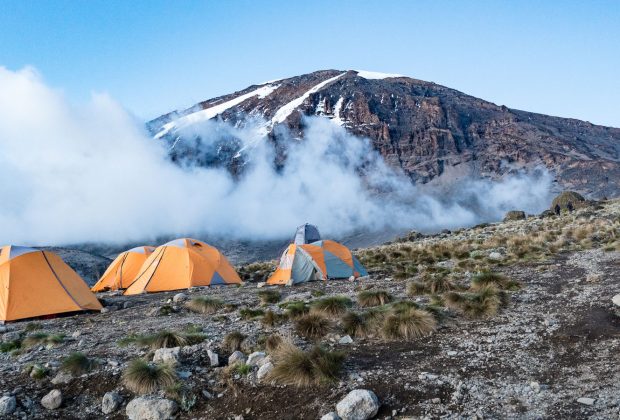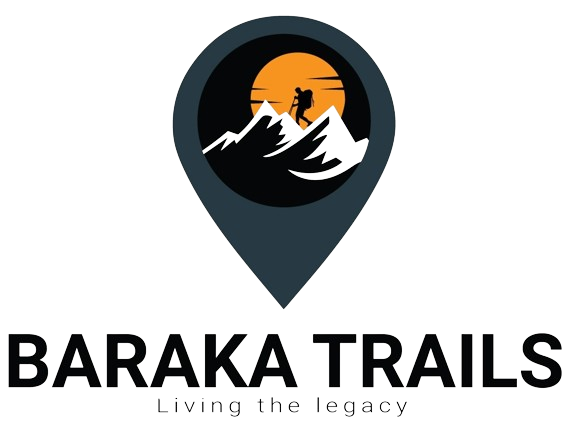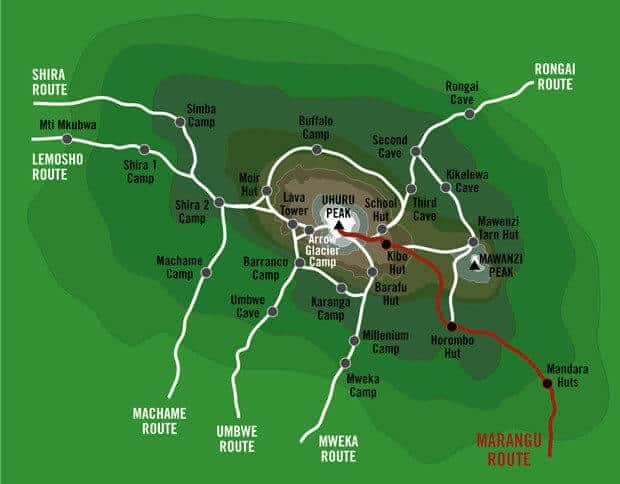7 Days Machame Route



MACHAME ROUTE
The trek begins at Machame Gate, located in the southern base of mountain, which is just a short drive from Moshi or Arusha.
The hike starts within Kilimanjaro’s lush, fertile, montane rainforest. As you might expect, the lower slopes receive a quite a bit of precipitation. The trail may be steep and slippery, so trekking poles are advised. As the route heads toward the Shira Plateau, the trees disappear and are replaced by low brush in the heather zone.
Then, the route climbs high to the volcanic plug, Lava Tower, before dropping and circling below the South Icefield. This circular pathway from Barranco to Karanga to Barafu is known as the southern circuit. As it traverses halfway around the mountain, climber’s are exposed to great vistas.
The long, strenuous approach to the summit is made from the east through endless switchbacks up increasingly loose gravel until we reach the crater rim at a mark known as Stella Point. Then the route is relatively flat for another hour to Uhuru Peak – the top of Mount Kilimanjaro. The quick descent follows the Mweka trail.
The Machame Route is approximately 62 km/ 37 miles from gate to gate, with an elevation gain of about 4,844Mt to 5,181Mt.
How Hard is it to Climb Kilimanjaro Using the Machame Route?
The Machame route is considered a difficult route. The reason being that it is a steep trail and has more elevation gain than other routes.
Day 1: Machame Gate (1790m) To Machame Camp (3010m)
One hour’s drive from Moshi lies the gate to the Machame route, where we complete park formalities, meet our crew of porters and start to climb! The first section of the route climbs steadily and passes through magnificent, dense rainforest. This path is less well-trodden so it can get somewhat overgrown in places and it is often wet and muddy underfoot.
- Distance covered: 10.8km / 6.7mi
- Approx. time taken: 6 hours
- Meals: Breakfast, Lunch & Dinne
Day 2: Machame Camp (3010m) To Shira Camp (3845m)
Our route continues on up through the forest until we reach the steep ascent onto the Shira Plateau, where there are rewarding views of the mountain. Looking back, you will be able to see Mt Meru rising high above Arusha town in the distance.
- Distance covered: 5.4km / 3.4mi
- Approx. time taken: 5 hours
- Meals: Breakfast, Lunch & Dinner
Day 3: Shira Cave (3845m) To Barranco Camp (3960m)
Walking now on high moorland, the landscape changes the entire character of the trek. We traverse the southwest side of Kilimanjaro, passing underneath the Lava Tower and the final section of the Western Breach and finally reach camp The day has been spent at altitude (up to 4600m), but we have followed the mountaineering code of ‘walk high, sleep low’ to aid your body’s acclimatization to altitude.
- Distance covered: 10.8km / 6.7mi
- Approx. time taken: 8 hours
- Meals: Breakfast, Lunch & Dinner
Day 4: Barranco Camp (3960m) To Barafu Camp (4640m)
Our day starts by descending into the Great Barranco, a huge ravine. We then exit steeply, up the Great Barranco Wall, which divides us from the southeastern slopes of Kibo. It’s a climb over rock, not technical, but long and tiring. Passing underneath the Heim and Kersten glaciers, we head towards the Karanga valley, which is our last stop for fresh water before the summit. Scree now forms the terrain as we walk through arid and desolate land towards Barafu camp.
- Distance covered: 8.5km / 5.3mi
- Approx. time taken: 8 hours
- Meals: Breakfast, Lunch & Dinner
Day 5: Karanga Valley (4,200m- Barafu Camp (4,640m)
After a good night’s rest and breakfast, we set off on our walk to Barafu camp at 4640m. The climb will take us across desolate scree slopes with no vegetation around us at all. It’s a tough steep walk made more difficult by the altitude. On arriving at camp we eat and spend the afternoon resting as we prepare for a long night and day ahead. It is important to keep hydrated and warm. We have an early dinner and then try to get some sleep as we will be getting up at between 11pm and 12pm to start the climb to the summit.
- Distance covered: 3km / 1.9mi
- Approx. time taken: 3 hours
- Meals: Breakfast, Lunch & Dinner
Day 6: Barafu Camp (4640m)-uhuru Peak (5895m)-mweka Camp (3100m)
We start off at around midnight, and walk steeply upwards to the summit glaciers. We will be climbing scree for 4 to 5 hours but gain incredible height over a short distance. The views are spectacular. We should be on the crater rim at Stella Point (5739m) as the first rays of the sun hit us. Spectacular ice cliffs within the crater surround us and the views to jagged Mawenzi peak and beyond are breathtaking. Another hour’s walking takes us to the summit, Uhuru Peak (5895m). We begin our descent by returning to Stella Point and then descending on scree slope and track back to Barafu Camp for breakfast, before finally heading down to Mweka Camp for a long well-earned rest.
- Distance covered: 16.4km / 9.6mi
- Approx. time taken: 13hours – 15hours
- Meals: Breakfast, Lunch & Dinner
Day 7: Mweka Camp (3100m)-mweka Gate (1630m)
A gentle trek takes us down through the rainforest to Mweka Gate, where we complete park formalities and receive certificates, which you can hang up with pride! We are then met by our vehicles and return to the hotel in Moshi, where you can treat yourself to a welcome shower then celebrate with cold drinks. Overnight at your arranged Hotel
- Distance covered: 9.1km / 7.5miles
- Approx. time taken: 3 hours
- Hotel: Bed &Breakfast
Departure After a much needed nights rest, we will bid you goodbye. If you have arranged airport transfers with us or a safari / Zanzibar trip, we will collect you in the morning for your onward journey
Included
- Park fees, camping fees & rescue fees
- 18% VAT on tour fees & services
- 3 Season mountain tents
- Double layered Sleeping Mats
- Transportation to & from the mountain gate
- Professional mountain guides, cooks and porters
- 3 meals daily while on the mountain
- Filtered water throughout the trek
- Pre & Post Trek accommodation at the hotel
- Fair wages for the mountain crew as approved by the Kilimanjaro National Park Authority (KINAPA), Kilimanjaro Association of Tour Operators (KIATO)
- 2- way private airport transfers
- Portable flush toilet with a toilet tent is extra
Not Included
- Flights
- Tips to mountain crew
- Items of a personal nature
- Laundry Services
What is Mount Kilimanjaro?
- Mount Kilimanjaro is the highest peak in Africa, located in Tanzania. It is a dormant volcano and one of the most iconic mountains in the world.
How tall is Mount Kilimanjaro?
- The summit of Mount Kilimanjaro, called Uhuru Peak, stands at an elevation of 5,895 meters (19,341 feet) above sea level.
How long does it take to climb Mount Kilimanjaro?
- The duration of a Kilimanjaro climb varies depending on the route chosen. Most climbs typically range from 5 to 9 days.
What are the different routes up Mount Kilimanjaro?
- There are several routes to the summit of Kilimanjaro, each with its own characteristics and scenery. Popular routes include the Marangu, Machame, Lemosho, Rongai, and Northern Circuit routes.
Is climbing Mount Kilimanjaro difficult?
- Climbing Kilimanjaro is challenging due to its high altitude, but it doesn’t require technical climbing skills. However, climbers should be physically fit and prepared for the rigors of high-altitude trekking.
Do I need a guide to climb Mount Kilimanjaro?
- Yes, it is mandatory to have a registered guide accompany you on your Kilimanjaro climb. Guides are essential for safety, navigation, and providing support throughout the trek.
When is the best time to climb Mount Kilimanjaro?
- The best times for climbing Kilimanjaro are during the dry seasons, which are typically from late June to October and from December to March. These months offer clearer skies and better trekking conditions.
What should I pack for climbing Mount Kilimanjaro?
- Essential items for climbing Kilimanjaro include proper clothing for varying temperatures, sturdy hiking boots, a good quality sleeping bag, trekking poles, personal medications, and other necessary gear as recommended by your tour operator.
What are the risks of climbing Mount Kilimanjaro?
- The main risks of climbing Kilimanjaro include altitude sickness, which can affect anyone regardless of fitness level, as well as other potential hazards such as extreme weather conditions and physical exhaustion.
Do I need to train before climbing Mount Kilimanjaro?
- Yes, it is highly recommended to undergo physical training and preparation before attempting to climb Kilimanjaro. This can include cardiovascular exercises, strength training, and hiking to build endurance and fitness levels.
Per Person $2,450/
GROUP $2,250

